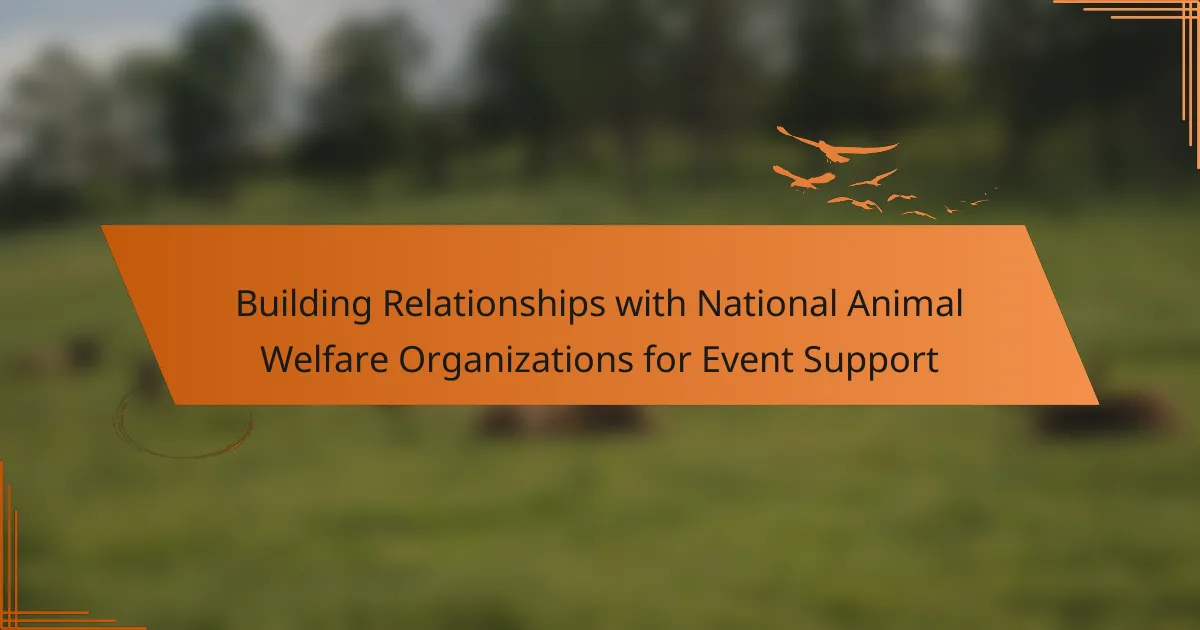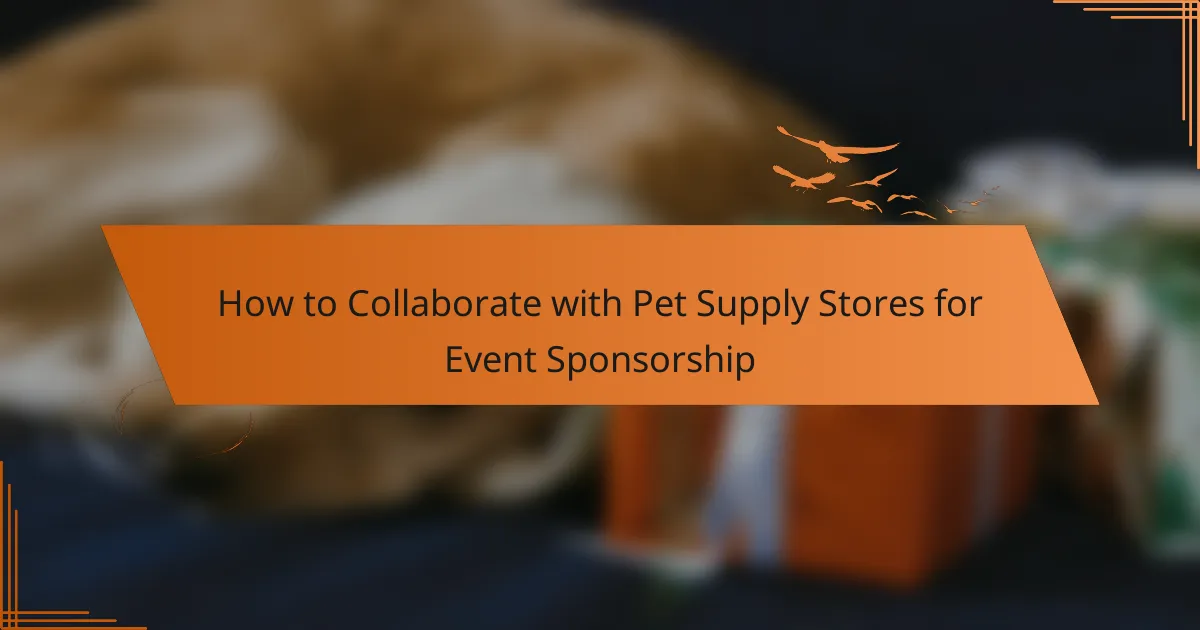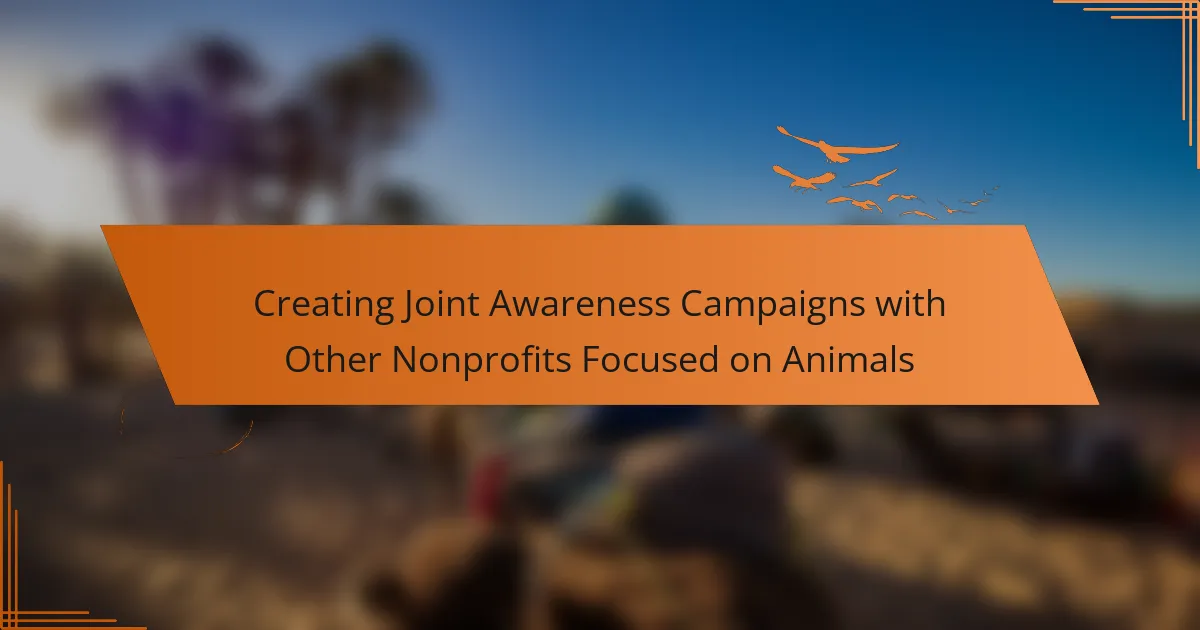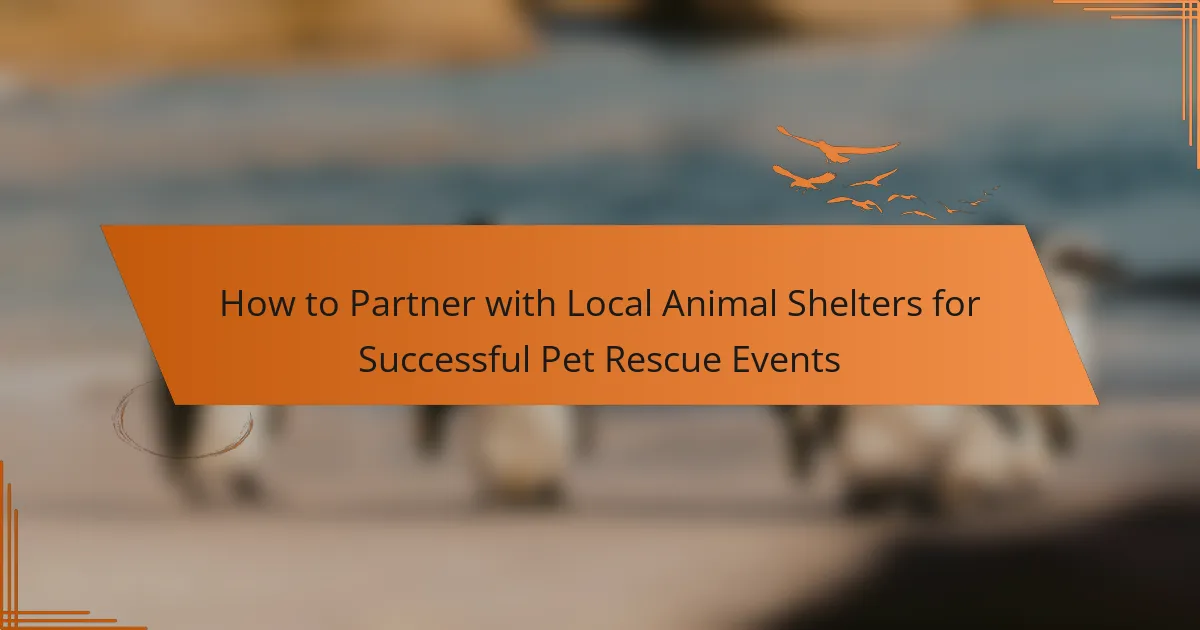Building relationships with national animal welfare organizations can greatly enhance the success of your events by providing valuable resources and promotional support. These collaborations not only increase visibility but also align with the shared mission of promoting animal welfare. By understanding their goals and fostering clear communication, you can create mutually beneficial partnerships that drive community engagement and support for animal rights initiatives.

How can national animal welfare organizations support events in the US?
National animal welfare organizations can provide significant support for events in the US by offering resources, partnerships, and promotional opportunities. Collaborating with these organizations can enhance event visibility and effectiveness while aligning with shared goals of animal welfare.
Partnership opportunities
Partnering with national animal welfare organizations can bring credibility and expertise to your event. These organizations often have established networks and resources that can help in planning and executing successful events, such as fundraisers or awareness campaigns.
Consider reaching out to local chapters of national organizations to explore co-hosting events or sponsorships. This collaboration can lead to shared costs and increased outreach, benefiting both parties.
Resource sharing
National animal welfare organizations can offer various resources that enhance event planning and execution. This may include access to volunteers, educational materials, or even venues for hosting events.
Utilizing these resources can reduce costs and improve event quality. For example, organizations may provide promotional materials or assistance in securing permits, which can streamline the planning process.
Promotion through networks
Leveraging the promotional networks of national animal welfare organizations can significantly increase event visibility. These organizations often have large followings on social media and established communication channels that can be used to promote your event.
To maximize this opportunity, create a clear promotional plan that outlines how the organization can share information about your event. This could include social media posts, newsletters, or announcements on their website, ensuring that your event reaches a broader audience.
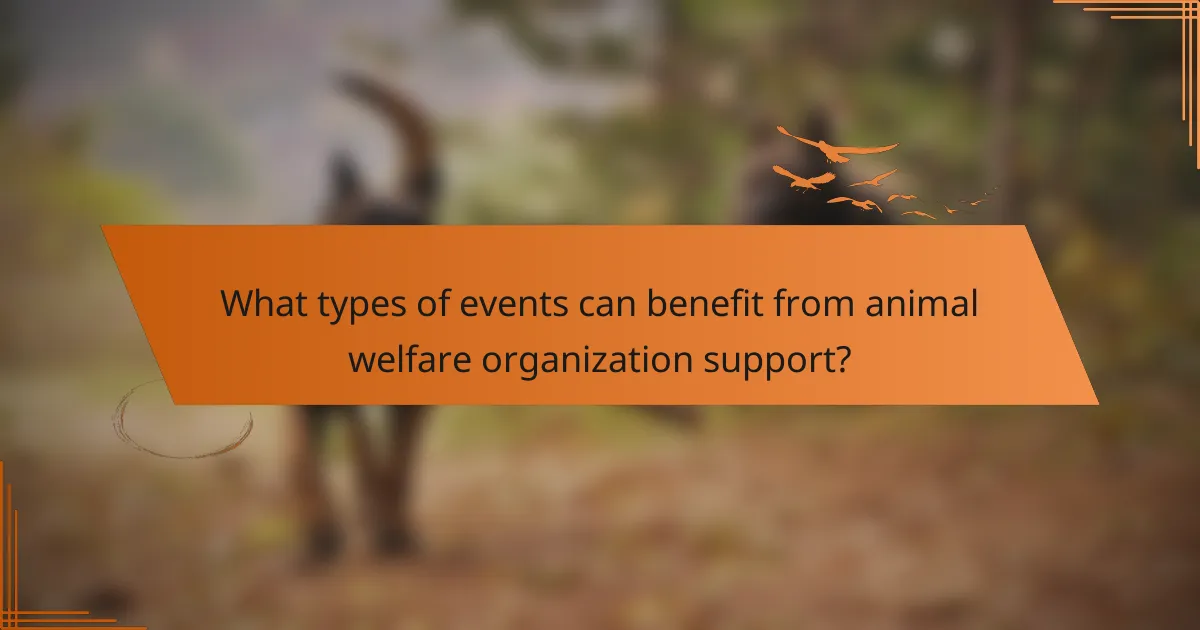
What types of events can benefit from animal welfare organization support?
Animal welfare organizations can support various events aimed at promoting animal rights, raising funds, or enhancing community engagement. Events such as fundraising activities, awareness campaigns, and community outreach programs are particularly effective in leveraging their resources and expertise.
Fundraising events
Fundraising events are crucial for generating financial support for animal welfare initiatives. These can include charity auctions, benefit concerts, or fun runs, where proceeds directly aid animal rescue operations or shelter maintenance. Collaborating with an animal welfare organization can enhance credibility and attract more participants.
Consider setting a clear fundraising goal and promoting it through social media and local networks. Offering incentives, like matching donations or prizes for top fundraisers, can also boost participation and donations.
Awareness campaigns
Awareness campaigns aim to educate the public about animal welfare issues and promote responsible pet ownership. These campaigns can take the form of social media drives, public service announcements, or community events that highlight the importance of spaying/neutering and adopting pets from shelters.
When planning an awareness campaign, focus on clear messaging and engaging visuals. Partnering with an animal welfare organization can provide access to resources and expertise in effective outreach strategies, ensuring your campaign reaches a wider audience.
Community outreach programs
Community outreach programs foster connections between animal welfare organizations and local communities. These initiatives can include free veterinary clinics, pet adoption events, or educational workshops on animal care. They help build trust and encourage community members to support animal welfare efforts.
To maximize impact, tailor outreach programs to the specific needs of your community. Collaborate with local businesses and schools to promote events and increase participation. Additionally, consider offering volunteer opportunities to engage community members actively in animal welfare efforts.

How to approach national animal welfare organizations for collaboration?
To effectively approach national animal welfare organizations for collaboration, start by understanding their mission and goals. Building a partnership requires clear communication and alignment of interests to ensure mutual support and success.
Research potential partners
Begin by identifying national animal welfare organizations that align with your event’s objectives. Look for groups that share similar values and have a history of supporting community initiatives. Resources like their websites, social media, and annual reports can provide insights into their focus areas and past collaborations.
Consider the size and reach of these organizations. Larger groups may have more resources but could also be more selective. Smaller organizations might be more flexible and eager to engage in new partnerships. Evaluate their past events and campaigns to gauge their effectiveness and relevance to your cause.
Craft a compelling proposal
Your proposal should clearly outline the event details, including the purpose, target audience, and expected outcomes. Be specific about what you are asking from the organization, whether it’s financial support, promotional assistance, or volunteer involvement. A well-structured proposal demonstrates professionalism and respect for their time.
Include a timeline and budget estimates to provide a clear picture of the event’s logistics. Visual aids like charts or infographics can enhance your proposal’s appeal and clarity. Tailor your proposal to reflect the organization’s mission, showing how your event aligns with their goals.
Highlight mutual benefits
When approaching national animal welfare organizations, emphasize the mutual benefits of collaboration. Explain how their involvement can enhance their visibility and outreach, potentially attracting new supporters and donors. Highlight any promotional opportunities, such as logo placement, social media mentions, or participation in event activities.
Additionally, outline how your event can contribute to their mission, such as raising awareness about animal welfare issues or generating funds for their programs. Providing clear examples of past successful partnerships can strengthen your case and illustrate the potential impact of collaboration.
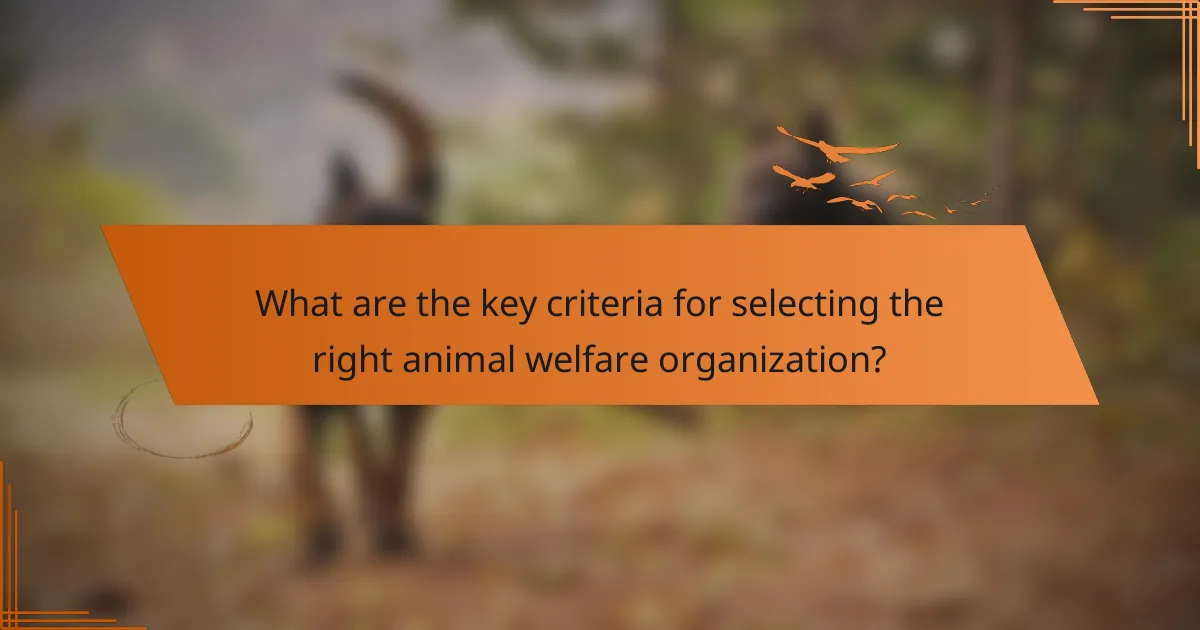
What are the key criteria for selecting the right animal welfare organization?
Choosing the right animal welfare organization involves evaluating several key criteria, including mission alignment, reputation, and previous event experience. These factors ensure that the partnership will be effective and mutually beneficial for both parties.
Mission alignment
Mission alignment refers to how closely the goals and values of the animal welfare organization match those of your event. A strong alignment can enhance collaboration and increase the impact of your efforts. For example, if your event focuses on rescuing stray animals, partnering with an organization dedicated to that cause will resonate more with your audience.
To assess mission alignment, review the organization’s mission statement and past initiatives. Look for shared objectives, such as promoting animal adoption or advocating for animal rights. This alignment will foster a more cohesive partnership.
Reputation and reach
The reputation and reach of an animal welfare organization are crucial for attracting participants and sponsors to your event. A well-respected organization with a broad audience can lend credibility to your event and help draw in more attendees. Check online reviews, testimonials, and social media presence to gauge their reputation.
Consider the organization’s reach in your community or target demographic. A local organization may have strong community ties, while a national organization might offer a wider audience. Balance these factors based on your event’s goals and target audience.
Previous event experience
Previous event experience indicates how effectively an animal welfare organization can contribute to your event. Organizations with a history of successful events are likely to have established processes and a network of supporters. Ask for examples of past events they have organized or participated in, and inquire about their roles and outcomes.
Additionally, consider their capacity to assist with logistics, marketing, and volunteer management. Organizations that have successfully executed similar events can provide valuable insights and resources, making your collaboration smoother and more effective.
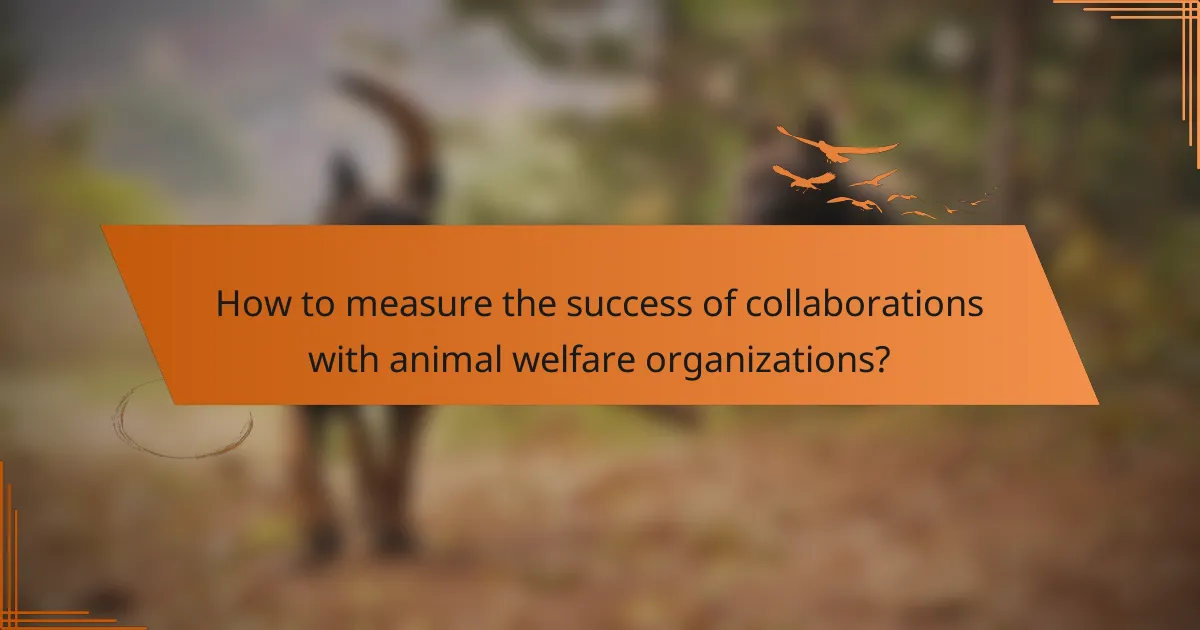
How to measure the success of collaborations with animal welfare organizations?
Measuring the success of collaborations with animal welfare organizations involves evaluating specific metrics that reflect the effectiveness of the partnership. Key indicators include event attendance, funds raised, and community engagement levels, which collectively provide insights into the impact of the collaboration.
Event attendance metrics
Event attendance metrics are crucial for assessing the reach and popularity of your collaboration with animal welfare organizations. Tracking the number of participants at events can help determine the effectiveness of promotional efforts and the overall appeal of the event.
Consider comparing attendance figures to previous events or similar initiatives. A significant increase in attendance may indicate successful outreach and heightened interest in animal welfare issues.
Funds raised
Funds raised during collaborative events are a direct measure of financial success and support for animal welfare initiatives. Establish clear financial goals before the event and track actual funds raised against these targets.
Evaluate the effectiveness of different fundraising strategies, such as ticket sales, donations, and sponsorships. A successful event typically raises funds that exceed initial expectations, contributing significantly to the partner organization’s mission.
Community engagement levels
Community engagement levels reflect how well the collaboration resonates with the local population. This can be measured through surveys, social media interactions, and volunteer sign-ups during events.
High engagement levels often indicate a strong connection with the community, fostering ongoing support for animal welfare. Consider implementing follow-up surveys to gather feedback and assess how the collaboration has influenced community attitudes toward animal welfare issues.
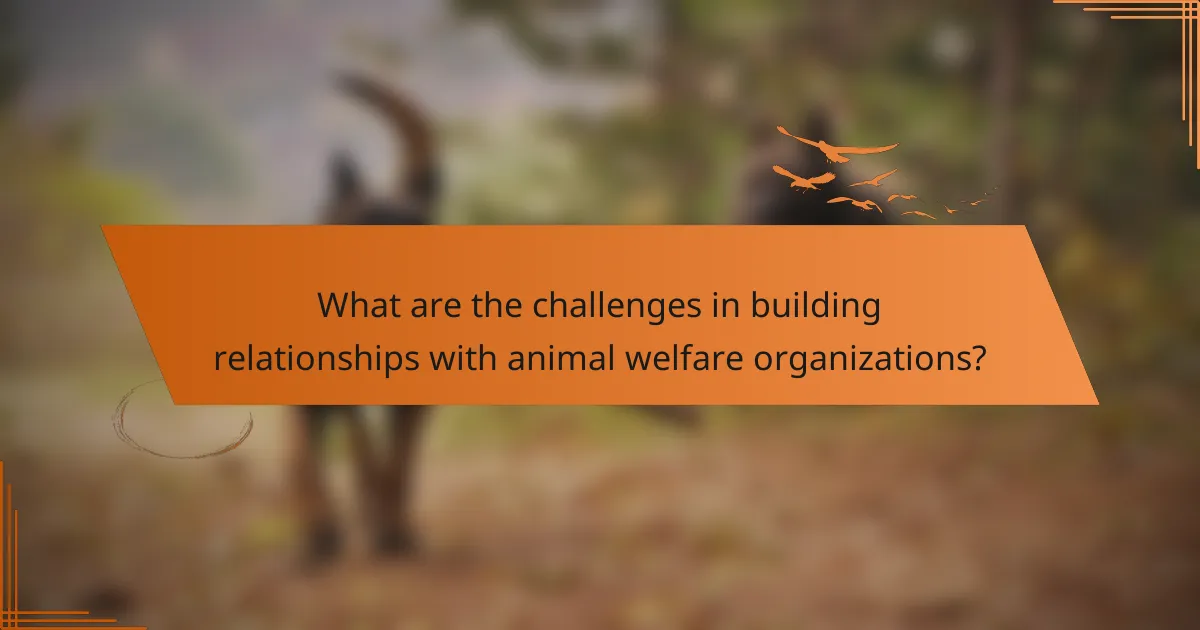
What are the challenges in building relationships with animal welfare organizations?
Building relationships with animal welfare organizations can be complex due to differing priorities, limited resources, and communication barriers. Understanding these challenges is essential for effective collaboration and support.
Understanding differing priorities
Animal welfare organizations often have specific missions and goals that may not align with your event’s objectives. For example, while one organization may focus on rescue and rehabilitation, another might prioritize advocacy or education. It’s crucial to identify common ground to foster a productive partnership.
To navigate these differing priorities, engage in open discussions to clarify each party’s goals. This can help in aligning your event’s purpose with the organization’s mission, creating a mutually beneficial relationship.
Limited resources and funding
Many animal welfare organizations operate with tight budgets and limited manpower, which can hinder their ability to support events. This scarcity of resources means they may prioritize larger initiatives over smaller events. Understanding this limitation is key to managing expectations.
Consider offering support that requires minimal resources from the organization, such as promoting their cause through your event or providing volunteers. This approach can help build goodwill and demonstrate your commitment to their mission.
Communication barriers
Effective communication is vital for building relationships, yet it can be a significant challenge. Misunderstandings may arise from different terminologies or communication styles between your team and the organization. Establishing clear channels for dialogue is essential.
Utilize regular check-ins and updates to ensure everyone is on the same page. Employing simple language and avoiding jargon can also facilitate better understanding. Consider using visual aids or written materials to reinforce key points during discussions.
